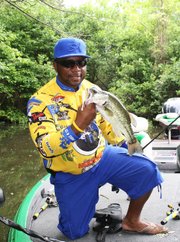Daytime bass fishing is dead slow on our reservoirs right now, but it's very good on the Arkansas River.
If you can endure oppressive heat and humidity, the Arkansas River is one of the few places where you can catch bass all day. That's because the river is a dynamic system that exhibits a full range of water conditions in its various pools over the course of a day. If you're in the right place at the right time, you can experience some memorable moments.
Winning $2,000 is certainly memorable, as Ricky Ellis of Cabot and Alan Stewart of Sherwood did Saturday when they caught five weighing 16.49 pounds to win the second annual Big Buzz Bass Tournament on the Arkansas River.
They caught their fish in the Little Rock Pool, which is the most unappreciated section of the McClellan-Kerr Navigation System. That weight is comparable to a good bag at Lake Dardanelle, which is one of the best bass lakes in Arkansas.
Even better was the 18.63-pound bag that Jonathan Evans and Kenny Baugh caught in Pine Bluff Harbor to win a Sherwood Bass Club tournament on July 15. They also took Big Bass honors with a 6.2-pounder.
Fishing the river successfully requires close observation and awareness of water conditions from one end of a pool to another. Ellis said he checks water flow data constantly, not just to know how much current is flowing, but to know if water is rising or falling in the upper, lower and middle portions.
Matt Lea of Conway, an accomplished Arkansas River angler, also said that current and water flow are the keys to deciphering the river's daily fishing patterns.
"You fish it differently at 20,000 (cubic feet per second), 30,000, 50,000 and 60,000 through 85,000," Lea said. "Fish will be in the strongest part of the current most of the time, and there's always a certain level of current that big fish want."
Current force-feeds bass, Ellis said, and he scans his electronic graph looking for shad. If he doesn't see them, he won't fish that spot."
Observation can key you in to small subtleties that inexperienced anglers will ignore or miss altogether, like a flock of birds diving in the distance. A casual eye might notice the birds and leave it at that. An experienced eye knows they are diving on shad, and when birds dive on shad, bass are feeding from below.
"I love it when I see gizzard shad jump out of the water because I know what's under them," Ellis said.
Wing dams, or jetties, are the river's most prominent features, and also the most dependable bass-holding structures. Lea said he usually spends the first hour of a fishing trip working the jetties because they always hold fish.
"Right now, the river is at 20,000 (cfs)," Lea said. "I still start shallow on jetties on the top and bottom."
If jetties aren't productive, Lea moves to other structure.
Tyrone Phillips of Little Rock and his partner Fred Martin of North Little Rock won the Fish 'N Stuff TNT bass tournament Tuesday night on the Arkansas River. Phillips agreed that jetties are the best places to start a bass fishing trip, and they can also be the best places to end one.
"They still got to eat no matter how hot it is," Phillips said. "Lately I've really been slowing down and fishing the fronts and edges of jetties where sand comes over the edge. Anytime I see fish come up, I'm going to throw a fluke and work it all the way back to the boat."
His favorite colors are reds and greens, and the amount of weight he uses depends on how deep the fish are and how they react to a falling bait.
"The better fish have been coming from around the bottom, so you really just have to slow down, even on the hookset," Phillips said. "A lot times a fish just grabs the tail, and sometimes I have to shake the bait so fish will get it. I'm throwing 10-inch worms, and a lot times it comes back with half of it missing."
Gary Hubble of Alexander said that sand attracts a lot of bass in the summer because sand is lighter colored than rock, which means it reflects heat instead of absorbs heat. Sand is cooler, so use it to get some relief from the heat.
"I guarantee you those fish will get on sand this time of year, and in the mornings you can catch them on topwaters," Hubble said.
Quincy Houchin, who won the Fishing League Worldwide Costa Series tournament on Lake Dardanelle in the spring, is a topwater aficionado. He also said sand is a good place to fish this time of year. He likes the Whopper Plopper and The One, by Paycheck Baits.
"If I'm catching them on sand, I stay on it all day," Houchin said. "I might throw a crankbait some, but they'll hit it all day, and they'll come from a long way to get it."
Topwaters can be dicey this time of year because there's so little current, Houchin said. If fish don't hit on top, he said he fishes brush and other submerged cover with a large worm.
Hubble said he's noticed a lot of small, subkeeper bass in the Arkansas River this year.
"The river is producing a tremendous amount of small fish," Hubble said. "You can go through 20-30 small fish before you catch a keeper, and you can catch 50 fish a day."
Lea and Ellis have noticed it, too, and that bodes well for the future. Today's small fish are tomorrow's big fish.
High water during the spawning season might have something to do with good production, but Lea and Ellis said it could also be attributable to the bass fingerlings that anglers release every year during the Arkansas Big Bass Bonanza. The Arkansas Game and Fish Commission traditionally gives anglers participating in the tournament bags containing 100 fingerlings to release wherever they wish. Naturally, they release them in their favorite fishing holes, which ensures even distribution in good fishing places.
Skeptics say it's a gimmick, and that releasing fingerlings in this manner only provides meals for big fish.
Ellis disagreed.
"If they can get to grass, they'll survive," he said.
Sports on 07/23/2017

